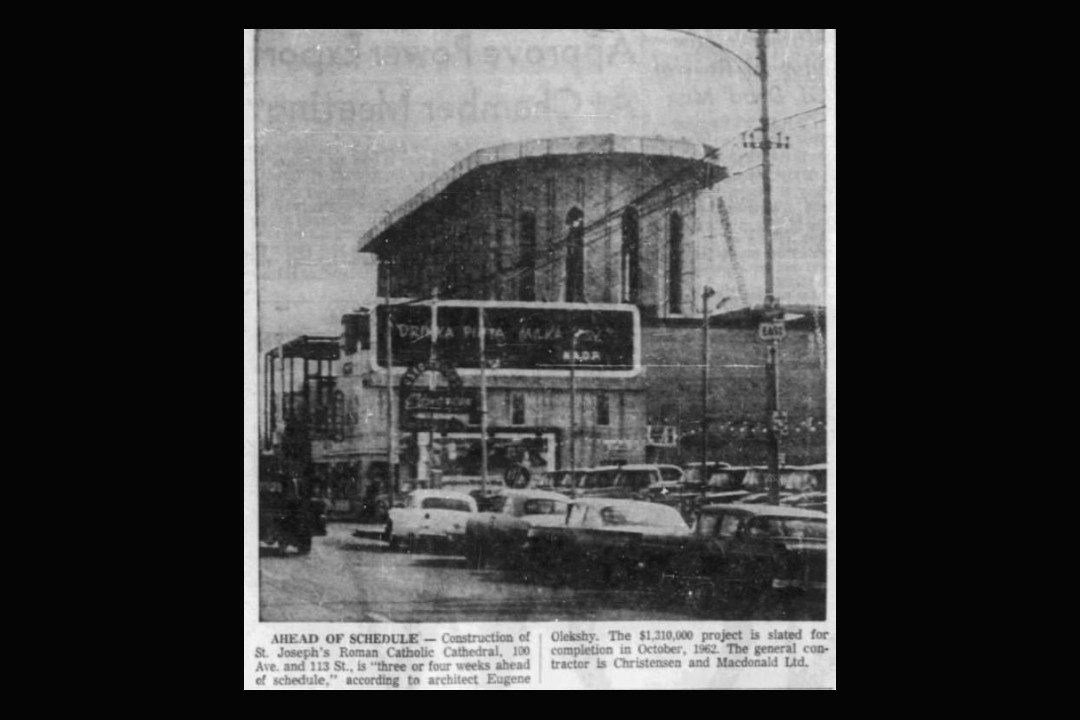On this day in 1961, St. Joseph's Cathedral was under construction. When it opened its doors two years later, it was the final step in the parish's long journey to find a permanent home — one delayed by world wars, the Great Depression, and other setbacks.
In Edmonton's early days, English-speaking Catholics didn't have their own church. Instead, they shared services with their francophone counterparts at St. Joachim Catholic Church, built in 1889. This arrangement worked out for a while, but by the late 1900s, there were more worshippers than space. So, in 1913, the English-speaking parishioners split off to form St. Joseph's.
They began work immediately on a new church building nearby. However, only the basement was finished before work had to be halted because of the First World War. (It certainly didn't help matters that the person working on the plan, prolific Edmonton architect Ronald Lines, was killed in battle in 1917.)
The basement was abandoned, and it would be years before construction could start again, this time at a new site on Jasper Avenue and 113 Street. By 1925, the basement was completed (for the second time), and St. Joseph's began holding services in its new, underground home, nicknamed "the crypt."
Less than a year later, Archbishop Henry Joseph O'Leary chose the little basement church as the site for his cathedral. Plans were drawn up to build a massive building on the site. Hundreds of feet tall, it would have towered over the rest of the city and likely would have been the largest building in Western Canada at the time. However, O'Leary's grand vision was not to be; the Great Depression, followed by another global war, would delay and ultimately dash those plans.
It wouldn't be until the late 1950s that a new plan — and funding — would see construction actually start on the cathedral. While it might not have been as ambitious as the original design, the new St. Joseph's is still impressive and lavish. It was built to seat around 1,200, and the exterior of the building is covered in distinctive speckled Tyndall limestone from Manitoba. Inside, Spanish stone was used for the altar, Quebec oak for the pews, and 23-foot stained-glass windows came from Munich. Also, apparently, some of the gold ceramic was originally ordered by Adolf Hitler and intended for a German rally during WWII. The cathedral boasted one of the largest pipe organs in the country, built by the famous Casavant Brothers.
When the cathedral opened in 1963, it was nicknamed "the church with no locks" as it was open 24 hours a day for prayer. This practice continued until 1980 when an arsonist destroyed the altar and crucifix and caused hundreds of thousands of dollars in damage to the building and the pipe organ. The doors are now locked at night.
The cathedral would host some familiar faces over the years. In 1984, Pope John Paul II led prayers there. His visit also saw the cathedral elevated in status to become St. Joseph's Basilica. Four years later, it was the site of the opulent wedding of Wayne Gretzky and actress Janet Jones (an event that caused some minor controversy, as neither was Catholic.)
Although it took a while to get there, the grand St. Joseph's Basilica still stands on the southern side of Jasper Avenue, a reminder of the history of Edmonton's Catholic community and a gathering place for its present one. The history of the Church, both in the city and the country as a whole, has seen a lot of critical reexamination in recent years, especially regarding its role in the residential school system and abuse scandals. Last month, the Edmonton Archdiocese was named in a lawsuit over abuse allegations at an Edmonton junior high school. And earlier this summer, the organization made a $3.2-million donation to Indigenous reconciliation efforts.
This clipping was found on Vintage Edmonton, a daily look at Edmonton's history from armchair archivist @revRecluse of @VintageEdmonton.

